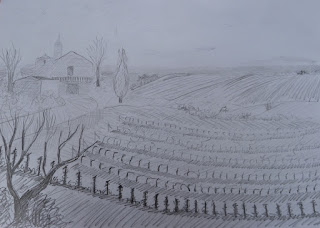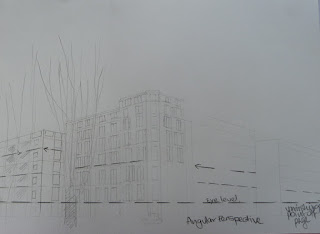360 degree Studies
Cloud Formations
Chalk and Charcoal
Oil Pastel
Conte Pastel
Plotting space through composition and structure
Check and Log
Q: In what way did you simplify and select in your study? Were you able to focus on simple shapes and patterns amid all the visual information available to you?
A: Using a viewfinder I was able to simplify and select the area that I wanted to draw. I am very familiar with this area and have often done sketches and quick water colour paintings so I instinctively knew what to draw.
I was very aware of the distinct areas of light and dark and try to emphasis these areas in the sketches.
Q: How did you create a sense of distance and form in your sketches?
A: I tried to use light and dark areas to create a sense of distance and form in the sketches. The use of darker grafite pencils helped me to define the foreground, middle and back grounds.
Q: How did you use light and shade? Was it successful?
A: I think that I was successful in my use of light and dark or I tried to be.
Q: What additional work would have been helpful towards the larger study?
A: I think that as with all work the more time you spend the better it is, however, sometimes you just have to stop and move on to the next piece.
Check and Log
Q:What problems did you find in executing perspective drawings?
A: The biggest problem for me was not understanding the vanishing point can move, but once I understood this it was easier. But to draw buildings there is so much to put in and I found that a bit overwhelming.
Q: Make notes on the merits of using, or not using rulers to guide you?
A: I like to draw without a ruler the initial beginning of the sketch to get the general layout of the scene. I then like to check with a ruler to see that the lines are correct. Ususally I was very close to the correct placement of the lines. I purchased a metre long ruler to make sure that the lines were correct. I have learned a lot during these exercises. In the past I would never have considered the possibility of drawing a townscape as I did not understand perspective.
Townscape using line
A townscape, the view from my balcony, the car driving down white lines in the street is a regular sight on the streets of Rome
A sketchbook of townscape drawings. A bit difficult to see, but its a drawing of a real estate office on the corner of two small streets, one going up the hill in a little village called Nemi.
Limited palette study from a sketch.
Drawing Statues, unfortunately this beautiful horse and roman rider is galloping off the page!
Check and Log
Q; How did you use a limited colour palette to create a sense of depth?
A: Using all three colours to make the darkest value created a sense of depth, I think.
Q: Did your preliminary sketches give you enough information for your final pieces of work?
A: I think that they greatly assisted my efforts to get things in the correct places.
Q; Would you approach this task differently another time?
A: I would have to say I would but just now I am not sure. I like to try to make a fresh approach to each study.
Q: Have you got the scale of the buildings right? Make notes on what worked and what did not.
A: I think I have the scale of the buildings right and I think that what I did worked. Of course the more experience you have in anything the better you will be. More practice will make things work better.
Q: Have you captured the colour and atmosphere in your studies? How did you do this?
A: I tried too capture the colour and atmosphere but using only three colours it was difficult for me.
Larger study of individual tree.
Study of several trees.
Check and Log
Q: How many different types of tree types have I drawn?
A: Throughout this assignment I have drawn many types of trees. I really enjoy drawing trees.
Q: What techniques did you use to distinguish each type?
A: I tried to draw the actual over all shapes of different types of trees and the line that the leaves make. Some trees like cyprus for instance are long and skinny and have long skinny branches that go straight up and others are short and round.
Q: What did you do to convey the mass of foliage?
A: I used different grades of grafite pencil and charcoal pencil and different kinds of lines and shapes.
Q: How did you handle light on the trees? Was it successful?
A: I used a lighter touch with the pencil or charcoal I think it was successful.
Q; Did you manage to select and simplify? Look at your drawings and make notes on how you did this and what you could do better.
A: Its always a challenge to choose exactly what to draw. I tried to look at the overall shapes, textures and the light and dark of what I chose to draw. I am sure that I can do better and will try to next time.
This is the final piece. I found it very difficult as I have avoided drawing buildings in the past. I think that the perspective is ok, but struggled with which details to include and which to omit. I have spent many hours and could continue but I had to stop at some point.


























